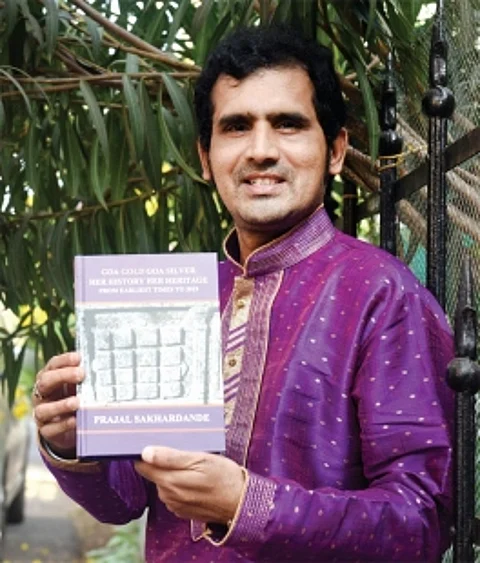

Prajal Sakhardande is the person to turn to when it comes to learning more about the history of Goa.
With his years of research on the different facets of Goa, his latest book,
‘Goa Gold Goa Silver Her History Her Heritage - from Earliest Times to 2019’,
will be released at the Sushegad Village, Veling, Ponda on May 13, 2019 at 5pm.
He believes that the book will throw light on the realm of heritage that he
defines as a positive legacy of history.
Prajal has been a
professor of History since 1993. He is the president and co-founder of Goa
Heritage Action Group and has been fighting for the preservation of Goa’s
historical, natural and cultural heritage and environmental heritage. He is
also a member of the Goa Board History Text Book Syllabus Drafting Committee
and University Syllabus History Committee. He was awarded the Goenkarponn Award
for History and Heritage on July 23, 2018.
“The book will fill
in the gap in Goan historiography and will be the first book on the history of
Goa to have a vast canvas offering a narrative from earliest times to 2019. No
previous book has attempted this huge spectrum of Goa’s history, which focuses
on the untold histories and the unsung people. It offers the vastness of a
chequered history with the highlights being the Pre 1510 Goa and the hitherto
not highlighted Andolans or people movements like the Opinion Poll of 1967,”
says Prajal Sakhardande, Head of the Department of History at Dhempe College of
Arts and Science, Miramar.
His first book,
‘Muslim History and Heritage of Goa’, was released in 2012, followed by
‘Matanhy Saldanha – the Legend’ with co author Santosh Sawant Wadkar in 2013.
“I have been working on this book since 2003. I have consulted primary and
secondary sources for this work. It was a huge challenge to obtain sources as I
had to verify each and every fact and line I wrote. In fact, every word had to
be authenticated,” adds Prajal.
The book is published
by Broadway Publishing House and printed by Rama Harmalkar and has at least 50
coloured and black and white photographs. The book is written with students and
general public in mind, to give an overview of the history of Goa. While most history
books deal with a specific theme or a time period, this particular book offers
the reader the complete story in simple language. “I feel every Goan should
know the basics of Goan history, especially the younger generation. History of
Goa was never taught in the pre 1991 days in schools,” he says.
What are the themes
that are touched upon in the book? Readers can learn more about the
Pre-Portuguese history with highlights of Kadamba era and pre-Kadamba era,
Portuguese Goa, Etymology of Goan surnames, taluka wise heritage list, Freedom
movement, Post Liberation Bandodkar Era, Shashikala Kakodkar, Rane regimes,
Coalition politics and Parrikar era till his death on March 17, 2019.
He was also a part of
various movements in Goa, which gave him a better understanding to write the
book. “I had the first hand information on movements like Heritage movement,
Goa Bachao Abhiyan, Anti SEZ movement, Goa’s movement for Special Status,
Mhadei Bachao Abhiyan, etc. Readers can also gain knowledge about the various people’s
movements that took place in the history of Goa like the Opinion Poll of 1967
with special reference to Dr Jack de Sequeira, student movements such as Half
Ticket Agitation, Ramponkar, Konkani movement, Konkan Railway, Nylon 6,6
Movement, Save Coconut Chipko Andolan of 2016, etc,” explains Prajal.
Prajal
formed the Goa Heritage Action Group on September 30, 2000 to pique the
interest of students in history. “I strongly feel there is a huge interest in
history now as compared to before. I am glad that a large percentage of the
current generation is taking a keen interest in heritage trails, heritage
walks, etc. We should preserve our heritage for posterity. Heritage tourism
should be promoted by the government on a war footing as an alternative to boost
its revenue so that its dependence on casinos for revenue generation should be
stopped,” concludes Prajal.